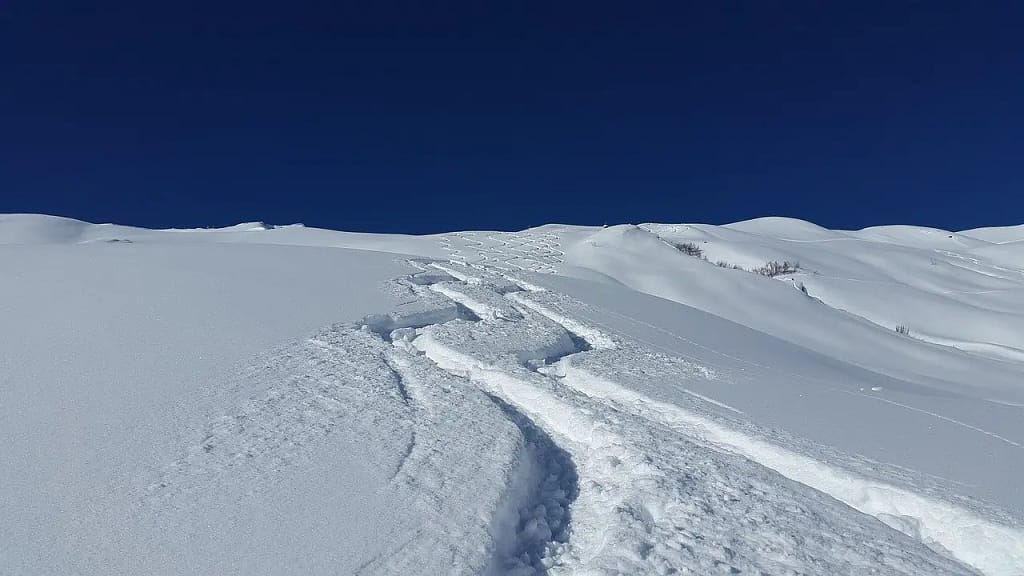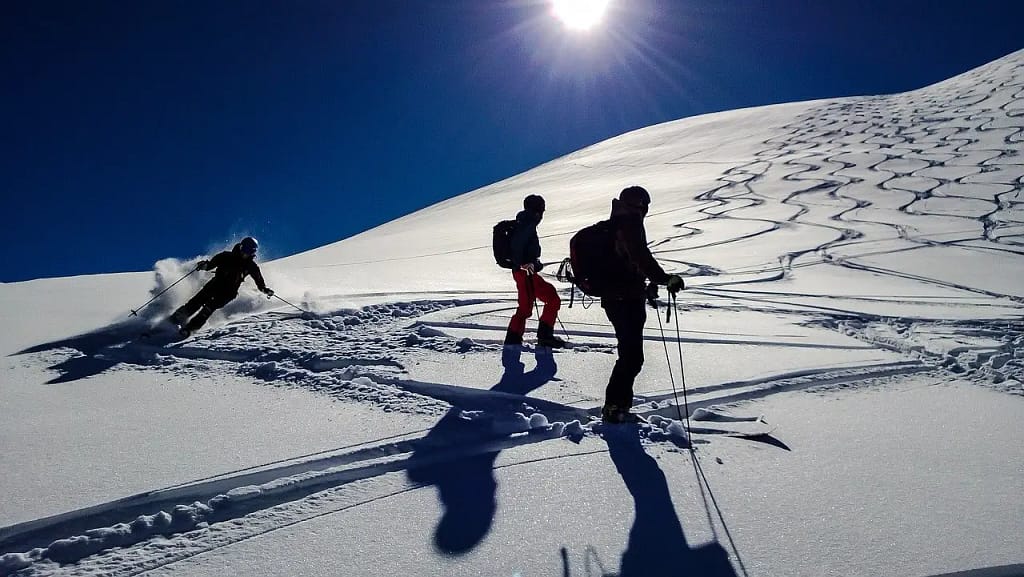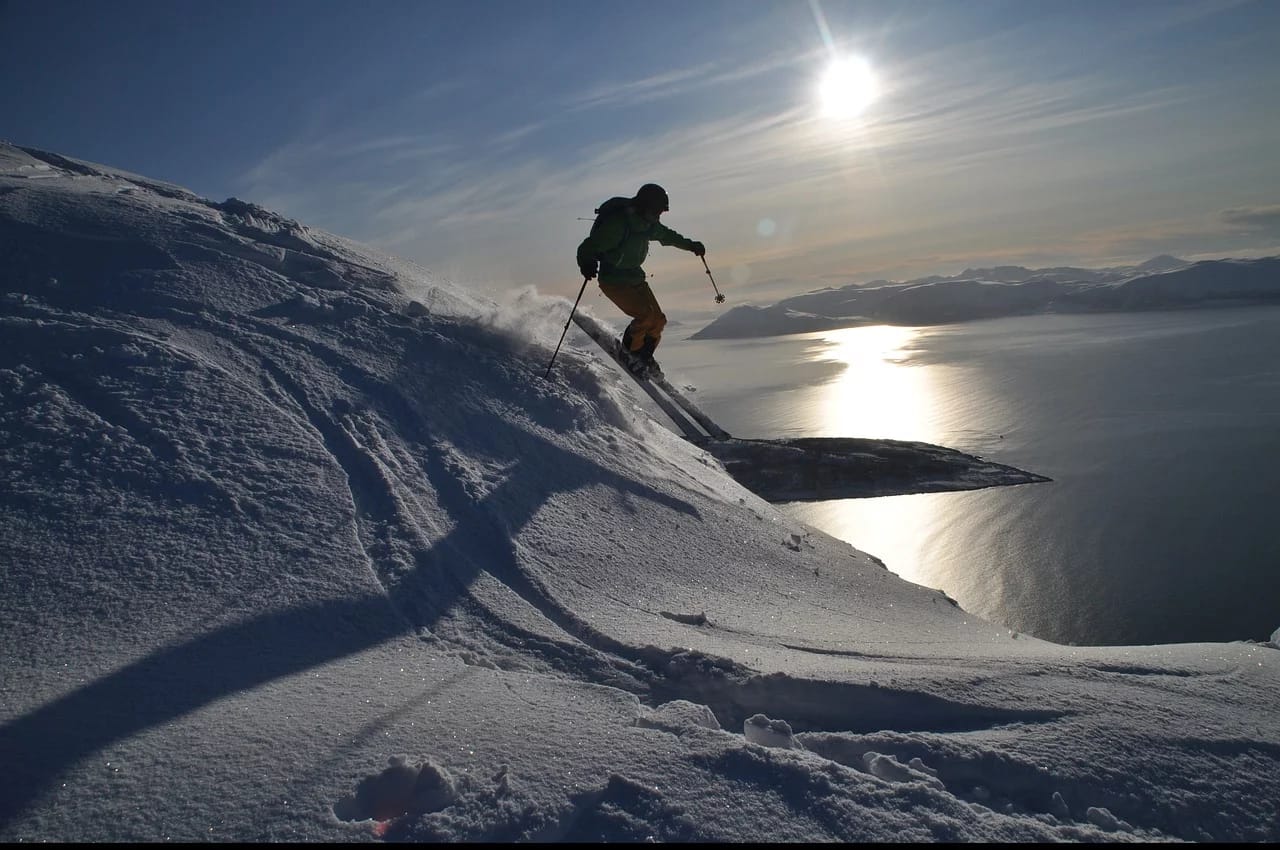Table of Contents
Introduction to Skiing in Powder Snow
Have you ever dreamed of gliding effortlessly through a winter wonderland? Skiing in powder snow is akin to floating on clouds, offering a surreal experience that beckons adventurers and thrill-seekers alike. With the right technique and equipment, the powder snow landscape becomes your canvas, and every turn paints a stroke of exhilarating freedom. Let’s dive into the essentials of mastering this snowy art form.

The Unique Experience of Powder Snow Skiing
How Powder Snow Differs from Other Types of Snow
Unlike the compacted snow on groomed trails, powder snow is loose, dry, and fluffy. It provides less resistance, which means you won’t hear the familiar ‘scrape’ of skis against the snow. Instead, you’ll find your skis submerged in a soft blanket, requiring a shift in technique to maintain balance and momentum. The deep, untracked snow offers a quiet, surreal skiing experience, often compared to surfing because of the way skiers can ‘ride’ the snow. It’s this unique feeling of buoyancy and freedom that makes powder snow the holy grail for ski enthusiasts.
As you venture into the world of powder skiing, you’ll quickly realize that it’s a dance with nature, where every turn is a brush stroke on a vast, white canvas. But to truly enjoy this art form, you’ll need to master the nuances of powder skiing. It’s not just about the thrill; it’s about becoming one with the mountain and the snow. So, are you ready to leave your mark on the slopes and experience the pure joy of skiing in powder snow? Let’s dive into the essentials that will elevate your adventure from good to unforgettable.
Essential Equipment for Skiing in Powder Snow
When you’re ready to conquer the mountain’s fluffy side, the right equipment for skiing in powder snow is as crucial as the snowflakes themselves. Imagine yourself floating effortlessly down the slopes, your skis acting as your wings – that’s the magic proper gear can provide.
Choosing the Right Skis
The foundation of your powder arsenal starts with the skis. Wider skis, often referred to as “fat” skis, provide the necessary lift to keep you on top of the snow. A waist width of at least 100mm is a good benchmark, but the deeper the snow, the wider you might want to go. Rocker technology, where the tip (and sometimes the tail) of the ski curves upwards, also aids in floatation and maneuverability.
Bindings and Boots
Bindings should match the type of skiing you’re planning to do. For powder, look for bindings that can handle the wider skis and provide the necessary support for your style of skiing. Boots, on the other hand, should offer comfort without sacrificing performance. A good fit is paramount, as is flexibility; a stiffer boot will give you more control in deep snow.
Poles and Other Accessories
Don’t overlook the importance of poles – in powder, they help you maintain balance and rhythm. Opt for poles with larger baskets to prevent them from sinking too deeply into the snow. Additionally, consider a helmet for safety, goggles with lenses suitable for low-light conditions, and breathable, waterproof clothing to keep you dry and warm.
Technical Advances
Embrace the latest in ski technology to enhance your powder experience. Innovations like lightweight carbon-fiber construction can make a significant difference in your fatigue levels after a long day on the slopes. And don’t forget about avalanche safety equipment – a beacon, probe, and shovel are non-negotiables in the backcountry.
Basic Techniques for Skiing in Powder Snow
Are you eager to carve your own path through untouched blankets of powder snow? Mastering the basics of powder skiing is essential for a blissful descent. The main keyword here, skiing in powder snow, isn’t just a skill—it’s an art form that, once perfected, can make you feel like you’re floating on clouds.
Body Position and Balance
The foundation of skiing in powder snow lies in your stance. Keep your weight balanced between both skis, and avoid leaning too far back, which is a common instinct. Imagine you’re standing in the middle of a seesaw, aiming to keep it level. This position allows your skis to rise to the snow’s surface, granting you that coveted sensation of surfing on snow.
Turning Techniques
Turning in powder requires a delicate dance with gravity. Start by gently shifting your weight towards the direction you wish to turn, and allow your skis to follow the curve naturally. Think of it as drawing wide arcs with a paintbrush—smooth, flowing, and unhurried. This method ensures you maintain momentum, crucial for skiing in powder snow, as it prevents you from sinking.
Maintaining Speed
Contrary to groomed runs, powder demands a consistent speed. It’s all about finding your rhythm; too slow, and you might stall, too fast, and you risk losing control. Aim for a steady pace that keeps you atop the snow. Visualize riding a wave, where speed is your ally in staying buoyant.
Common Mistakes to Avoid When Skiing in Powder Snow
Even the most seasoned skiers can falter in powder. Beware of these pitfalls: sitting back too far, over-rotating your body, and making jerky movements. Instead, stay relaxed, keep your movements fluid, and let the mountain guide you. Remember, powder skiing is a symphony, and you are the conductor—graceful, poised, and in control.

Advanced Techniques for Powder Snow Skiing
When you’ve mastered the basics of powder snow skiing, it’s time to elevate your skills to the next level. Advanced techniques can help you navigate the deepest snow and steepest slopes with grace and agility. Let’s dive into the strategies that will help you make the most of your powder days.
Mastering the Art of Weight Distribution
One key element in advanced powder skiing is learning the subtle art of weight distribution. Unlike on groomed trails, where your weight is more evenly distributed between your skis, powder skiing often requires a slight shift towards the back. This doesn’t mean leaning back, but rather, keeping your center of mass over the middle of your skis to allow the tips to rise above the snow. Imagine a scale under your feet, always fine-tuning the balance to stay afloat in the fluffy white.
Carving Your Path with Precision
Advanced powder skiers know that carving is not just for hard-packed snow. In powder, the technique changes slightly, with turns initiated by a subtle rolling of the knees and ankles. It’s like drawing a line with a fine brush – each movement is deliberate and precise, leaving a signature trail behind you.
Conquering Steep Terrain
Steep slopes can be intimidating, but they are also incredibly exhilarating. The key to conquering them lies in maintaining a steady rhythm and using a series of short, controlled turns. It’s akin to a dance, where each step is calculated and every movement is in harmony with the mountain’s rhythm.
Navigating Tree Runs and Variable Conditions
Trees can offer the best powder but require quick reflexes and a strategic approach. Keep your eyes focused ahead, not on the obstacles, and use pole plants to aid in quick direction changes. It’s a game of anticipation, where you must think two turns ahead and be ready to adapt to the ever-changing snow conditions.
Utilizing Terrain Features
Advanced skiers use the natural features of the terrain to their advantage. Rollers, banks, and gullies can be used to initiate turns or control speed. It’s about being one with the mountain, using its contours like a wave, with each turn flowing seamlessly into the next.
Safety Tips for Skiing in Powder Snow
When the mountain is blanketed with that irresistible fresh powder, it’s easy to get caught up in the excitement. But, safety should always be your top priority. Navigating the fluffy stuff can be a dream, but it’s not without its risks. Let’s dive into some essential safety tips to ensure your powder day remains a blast from start to finish.
Avalanche Awareness: Your Lifesaving Knowledge
Did you know that 90% of avalanche accidents occur on slopes with a 30-45 degree incline? It’s a stark reminder that knowledge is power. Before you even click into your skis, get clued up on the current avalanche reports. Attend an avalanche safety course, and never underestimate the mountain. Equip yourself with a beacon, probe, and shovel, and know how to use them. This isn’t just gear; it’s your lifeline.
Emergency Preparedness: Hope for the Best, Plan for the Worst
It’s a sunny day, and the powder is perfect, but weather in the mountains can change in the blink of an eye. Pack a small backpack with essentials—water, snacks, an extra layer, and a first aid kit. A whistle can be a simple yet effective tool for signaling your location. Remember, preparation is the companion of the wise and the protector of the skier.
Buddy System: Two Heads Are Better Than One
Always ski with a friend and keep each other in sight. It’s not just about sharing the joy of that powder turn; it’s about safety. If one of you gets into trouble, the other can act swiftly. A quick response can make all the difference, and besides, who doesn’t love a good ski buddy?
Stay Informed: Knowledge Is as Crucial as Your Ski Pass
Lastly, stay updated. Resorts often share vital information about conditions. A quick check on the resort’s website or a chat with the local ski patrol can arm you with the latest insights. Knowledge isn’t just power; it’s your passport to a safe and exhilarating day on the slopes.
Conclusion: Embrace the Powder Snow Skiing Experience
As the sun dips below the mountain peaks, casting a golden glow over the untouched powder, it’s clear that skiing in this winter wonderland is an experience like no other. Embracing the powder snow skiing experience is about more than mastering a new terrain—it’s about capturing the essence of freedom that comes with gliding through the soft, fluffy snow. It’s about the rush of adrenaline when you find your rhythm and the world around you fades into a blur of white and blue.
Whether you’re a seasoned pro or a curious novice, the allure of powder snow is undeniable. It’s a playground for the adventurous, a challenge for the skilled, and a dream for those who love the mountains. With every turn, every spray of snow, you’re not just skiing—you’re creating memories that will last a lifetime.
FAQ Section
1. What makes powder snow different from other types of snow?
Powder snow is often referred to as “freshies” or “the white room” by enthusiasts because of its light, fluffy texture. Unlike compacted or icy snow, powder snow hasn’t been affected much by wind, temperature changes, or skier traffic. It’s composed of fresh, loose ice crystals that can feel like skiing on a cloud. This type of snow provides a smooth ride and allows for a sensation of floating which is a unique and exhilarating experience. However, it also requires different techniques to maintain balance and control.
2. What type of equipment do I need for skiing in powder snow?
For the best powder snow experience, you’ll want to gear up with wider skis. These skis, often called “powder skis,” have a larger surface area to help you float on top of the snow. They typically feature a rocker design, which means the tips and tails are curved upwards, making it easier to turn in deep snow. Besides skis, consider a helmet, goggles with good peripheral vision, and layers of clothing to manage varying temperatures. A beacon, probe, and shovel are also essential if you’re venturing into backcountry or avalanche-prone areas.
3. What are the basic techniques for skiing in powder snow?
When skiing in powder, your stance should be a bit wider to provide stability. Keep your weight balanced or slightly back to avoid nose-diving into the snow. Use a more even weight distribution between your skis compared to groomed runs. Also, focus on making smooth, rounded turns and try to keep a consistent rhythm. Practice patience with your turns, allowing the skis to float up before initiating the next turn. And remember, speed is your friend in powder—it helps you maintain momentum and float.
4. Are there any specific safety precautions I should take when skiing in powder snow?
Absolutely. First and foremost, be aware of the avalanche risk. Always check the local avalanche forecast before heading out and consider taking an avalanche safety course if you’re planning to ski in the backcountry. Ski with a partner and make sure you both have and know how to use avalanche safety gear. Stay in control and be aware of tree wells and other hidden obstacles. Lastly, make sure someone knows your plans and expected return time.
5. Can beginners learn to ski in powder snow, or is it only for advanced skiers?
Beginners can definitely learn to ski in powder, but it’s important to have a solid foundation on groomed runs first. Powder skiing can be unforgiving, so being comfortable with basic turns and stops on a more forgiving surface is key. Once you’re ready, start with shallow powder on gentle slopes. Consider taking a lesson focused on powder skiing to learn the proper techniques. With practice, you’ll improve and be able to tackle deeper, steeper powder runs!
References for Further Reading
- Powder Magazine’s Skiing 101 – A great resource for learning the basics of powder skiing.
- Backcountry’s Training for Ski Touring – Essential reading for preparing for backcountry adventures.
- Avalanche Canada – An excellent source for avalanche safety and education.





No responses yet